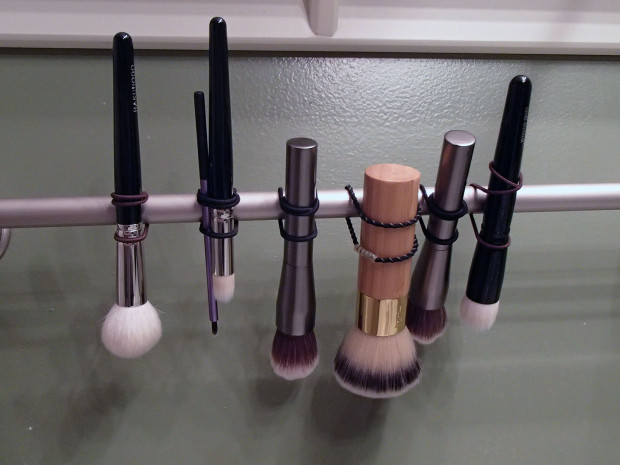All About Brushes: Care & Feeding
Now, after a long journey, we’ve come to the least sexy but maybe the most important part of the All About Brushes series – how to not destroy them! A good brush should last you a long time, but obviously taking care of it will help make sure it lasts as long as it should. There’s not really any single best way to care for brushes, but I’ll lay out the basics of how I do it.
Storage
Take it from my experience – throwing your brushes just any old place is a quick path to mangled hairs and misshapen brush heads. Everyone has their own way of storing brushes, but the main thing is to put them away carefully and make sure the hair isn’t getting smashed out of place. I like to store mine standing up instead of lying down, so that the hair doesn’t get flattened out on one side. For brushes you don’t use as frequently, it’s a good idea to keep them covered so they don’t get dusty. For traveling you can use brush guards or a brush roll to help the hairs keep their shape.
Cleaning
Cleaning your brushes regularly is an absolute must – unless germs are your thing. Giving them a good wash will keep them from spreading bacteria all over your face and eyes (even more important if you’re acne or stye-prone). They’ll also perform better and look nicer. When products build up in the bristles, it can keep brushes from blending as well or mix the colors of your products. Letting bright or dark colors sit on certain hair types can even stain the bristles.
Frequency
I wash my brushes according to the hair type and products they’re used with-
- Foundation brushes – after every one or two uses. I’m way too lazy to wash every day, so I have a few foundation brushes that I rotate.
- Goat/horse/synthetic hair (used with cream or powder) – I try to wash these about once a week, maybe sooner if I’ve used dark or bright colors on white brushes. These bristles are more sturdy, so they can handle more frequent washes.
- Squirrel (used with powder) – these get washed every two weeks unless I notice product buildup or am having trouble getting a certain color out. This hair is more fragile, so I don’t want to over-wash it.
You can also spot-clean your brushes in between washes. For goat/horse/synthetic bristles I use an alcohol-free makeup remover wipe to wipe off any excess product. For squirrel I just brush it on a dry tissue until no more color comes off.
Brush cleanser
I’ve had the best results by using very gentle cleansers – basically my rule of thumb is if I wouldn’t put it on my own hair, I won’t put it on my brushes either. My favorite brush cleaner? Plain old baby shampoo. Harsh cleansers can dry the hairs out, so I’d rather avoid them. A lot of ‘daily brush cleaners’ are alcohol-based, but I won’t let them anywhere near mine. They make sense for pro makeup artists who need their brushes to dry quickly between clients (and who are probably tax-deducting their brushes as a business expense), but for personal brushes, odds are you aren’t going to need your brush to be sanitized and dry within a few minutes. I’ve also followed (bad) advice to soak my brushes in a mixture of water and rubbing alcohol to help get products out; it turned out to be a terrible plan, since alcohol can break down the adhesives that hold the bristles together. Those brushes started shedding way before their time. Don’t repeat my mistakes!
Cleaning method
Some people like to put a mixture of shampoo and water on a plate and swirl their brushes in it. Personally, I just wet the brush, put shampoo in my hand and rub the bristles around until I see the product start coming out, then rinse it. Sometimes it takes a couple of shampoo/rinse cycles before it’s completely clean, especially for brushes that were used with liquid or cream products. A few tips on washing technique-
- Hold the brush upside-down while you’re washing it to keep water/shampoo/gunk from running into the ferrule and breaking down the adhesives.
- For the same reason, use lukewarm water, and try not to let too much water run over the ferrule.
- For the love of all things good, never submerge your brushes.
Be sure to thoroughly rinse out all the shampoo, and (gently!) squeeze out the excess water.
Drying
In the spirit of not letting too much water get into the ferrule, I always dry my brushes head-down. You can do this either by propping them on an angled surface, or by hanging them up. I’ve seen all kinds of inventive ways to hang brushes to dry, but my personal favorite is using hair elastics to attach them to my towel rack:
This keeps water from seeping to the base of the brush head. If you need your brushes to dry more quickly or you live in a humid climate, you can point a small desk fan on them. I don’t recommend hair dryers – they tend to blow the hair out of shape and I can’t imagine warm air is great for the bristles anyway.
And that’s all folks! Unless I forgot something :-) If you have your own tips & tricks, or questions, let us know in the comments!


Rads
February 5, 2014 at 12:26 pmThe hair elastic tip is just awesome! Thanks for sharing :D :D
I wash my brushes pretty much the same way as you have mentioned..I do find that it’s easier to wash off the gunk from the brushes (I don’t really let the products build up so much before a wash) but it takes soooo much rinsing to get shampoo residue out of the brush :( I might have lost more hair with my rinse rinse rinse rather than for any other reason!!!